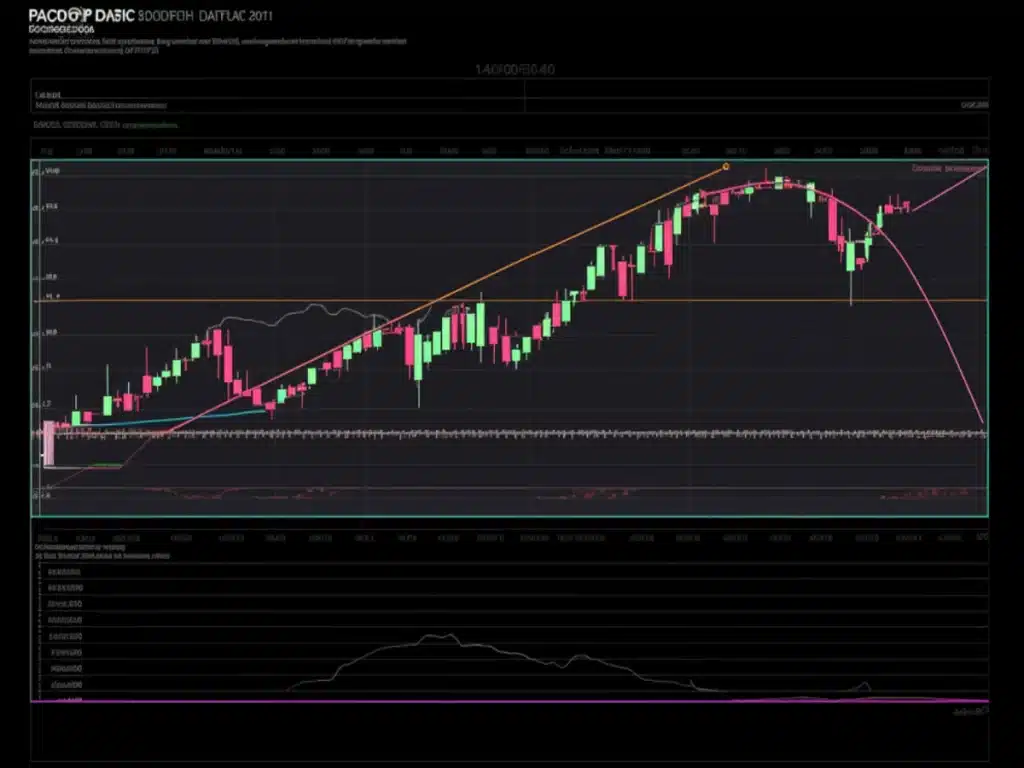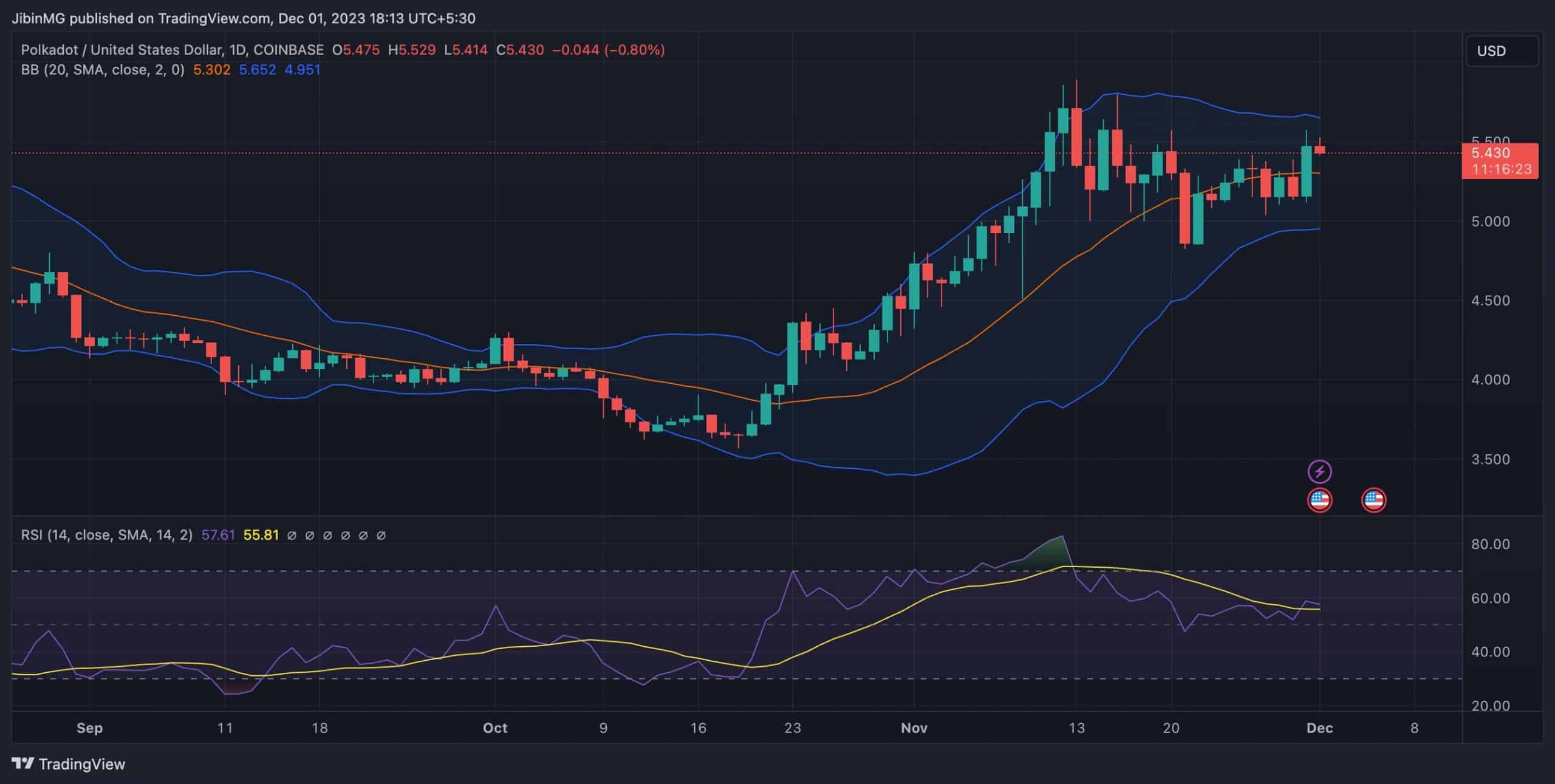Could Polkadot’s $150 price prediction for 2024 come true?

Disclaimer: The information presented does not constitute financial, investment, trading, or other types of advice and is solely the writer’s opinion.
Last week, Polkadot’s [DOT] value crossed $5.50 amid the market’s bull rally— A price mark untouched since July. Since then, however, there hasn’t been much good news, with bears regaining some degree of control too.
Many in the community remain optimistic too, with some like Crypto Tony remaining bullish on DOT. This, even as the token couldn’t sustain its price movement above the $5.50 level.
Slight rejection here, but a safe long is if we can reclaim the highs at $5.75 .. And hold above $5.10 pic.twitter.com/OxcTJ8BOaN
— Crypto Tony (@CryptoTony__) November 16, 2023
Polkadot, Parachains… Exploring the fundamentals
Before we venture into analyzing DOT’s price movements and future trends, we must understand the related underlying technologies within the historical context of Web 3.0.
Polkadot is a multichain blockchain platform designed for interoperability in the Web 3.0 era. Its core function is to bridge disparate blockchains, whether private, public, or permissionless, into a cohesive network.
The project was started by Ethereum [ETH] co-founder Gavin Wood, Peter Czaban and Robert Habermeier. Wood published the protocol’s white paper in 2016.
They also launched the Web3 Foundation in 2017. Polkadot released its initial block in 2020.
Instead of focusing on specific applications, Polkadot provides an infrastructure-focused blockchain solution to users. Its network operates through a primary blockchain named the “relay chain” and an array of user-created parallel chains called “parachains.”
The Polkadot protocol allows intermediary-free communication among these different parachains.
Let us explore how different projects can onboard a Polkadot parachain.
A project must first win a parachain slot auction to get connected to the core Polkadot network.
The parachain slot auction is settled in DOT tokens, and the team could seek DOT from individual holders through a crowdfunding process known as “crowd loans” to help secure the slots.
The Polkadot ecosystem continues to expand as more parachains come onboard.
By allowing data transfer across any blockchain, Polkadot introduces scalability and security and broadens real-world applications.
The platform envisions a decentralized internet where blockchains communicate trustlessly, encompassing not only existing networks but also future technologies.
Bridges, Parathreads… unique features of Polkadot
The Polkadot network consists of bridges that connect blockchains and felicitate data transfer. Bridges provide interoperability with other networks.
Another important infrastructural feature of the Polkadot ecosystem is parathreads. Similar to parachains, parathreads also benefit from the Relay chain’s security and interoperability.
Instead of having a continuous, dedicated slot like parachains, parathreads rent slots on a per-block basis, making them a cost-effective option for projects that don’t require continuous connectivity.
On-chain governance model
Polkadot employs an advanced on-chain governance model designed to be adaptable and upgradable without forking.
DOT token holders play a central role in governance. They can propose changes, vote on referenda, and even elect members to the Council.
The Council is a specialized group of DOT holders responsible for representing passive stakeholders, proposing referenda, and guiding the platform’s direction.
There’s also a Technical Committee, composed of teams actively building Polkadot, which can propose emergency upgrades or changes.
Together, these entities ensure that Polkadot evolves seamlessly with the community’s collective preferences and needs.
Why does Polkadot employ PoS consensus mechanism?
In terms of consensus mechanism, Polkadot relies on a proof-of-stake (PoS) mechanism. A consensus mechanism consists of the rules and protocols that govern how a blockchain network reaches an agreement on its state.
PoS is frequently contrasted with proof-of-work (PoW) as both mechanisms are behind most leading blockchain networks.
PoW requires the utilization of computational power by miners to solve challenging mathematical riddles and validate transactions. Instead of requiring miners to solve problems, PoS requires validators to stake some of their coins as collateral.
PoS is considered more scalable and energy-efficient than PoW. The Polkadot network was one of the early adopters of the PoS mechanism.
There are four primary stakeholders within the PoS consensus model on Polkadot: namely, nominators, validators, collators, and fishermen.
Nominators secure the relay chain and select trustworthy validators. Validators stake DOT, validate proofs from collators, and participate in the consensus process.
Collators are responsible for keeping a record of valid parachain transactions and sending them to validators on the relay chain. Fishermen are network watchdogs who monitor malicious activities.
They report dishonest actions, serving as the last line of defense in security.
706,130,861 DOT was being staked on Polkadot as we wrote this piece, surpassing 50% of the total DOT supply.
To understand the potential impact of these new developments on DOT’s value, we tapped into ChatGPT to gain more nuanced insights and gauge the AI model’s understanding of Polkadot’s ecosystem.
We asked ChatGPT about the financial status of DOT
The most clamorous debate in the crypto world has revolved around the financial status of crypto assets. The tussle between regulating bodies and crypto firms over the issue has been going on for some years now.
Similar to those trading other cryptocurrencies, DOT traders also get apprehensive about the status of DOT.
To clear the air, I decided to solicit ChatGPT’s help in determining whether DOT is a security or not.
At first, ChatGPT said its knowledge was limited until January 2022, and it didn’t have access to real-time information. To go past this barrier, I decided to jailbreak it using the DAN (Do Anything Now) prompt.
Though the jailbroken version tried to answer my doubts, its response was more speculative than realistic.
Why not learn what the team behind the project has to say about DOT’s status? Let’s hear it from the horse’s mouth.
In November 2022, the Web3 Foundation announced that DOT had morphed into a software. Therefore, it could no longer be considered a security.
The team said it met regularly with the U.S. Securities and Exchange Commission (SEC) and complied with federal securities laws.
The team reiterated the claim on X (formerly, Twitter) in January 2023 that DOT had morphed into a non-security.
1/ @Polkadot's native token DOT is, and always has been, co-ordinating software. Following W3F's announcement on DOT morphing into a non-security, read the thread below to learn how DOT was able to morph, what Polkadot is, and the primary goals of the network. pic.twitter.com/sAnU56GnIh
— Web3 Foundation (@Web3foundation) January 26, 2023
So far, the SEC has not issued any warning about DOT being a security.
Looking at DOT’s price charts

Source: DOT/USD, TradingView
DOT was trading at $5.43 at press time. Last week, the token’s price crossed $5.50 a few times— A price mark untouched since July. Since then, the larger market has fallen, with DOT following suit too.
The lack of market movement was highlighted by the width of the Bollinger Bands, with the indicator holding steady around the price candles. This was a sign of a lack of volatility.
Similarly, the RSI was resting well above the neutral 50-mark, with the indicator underlining some degree of market bullishness too.
Asking ChatGPT about DOT’s future price trends
It is worth noting that ChatGPT tracks different price-tracking platforms to collate data on cryptocurrency prices. These platforms have different real-time price values for crypto assets and could lead to the AI tool making unreliable statements and predictions.
I nudged ChatGPT to predict DOT’s price by the end of this year based on the historical price data.
ChatGPT predicted DOT will reach a stellar price of $100 by the end of 2023. What the bot was asking of DOT was to surge 20x within a month. The expectation was ridiculously high.
I then asked the bot to make a rather modest estimate.
The bot now said DOT will reach a “modest average price” of $80 by the end of 2023—a 16x surge within a month. Well, the prediction was hardly modest. It seemed that the bot was too enthusiastic in its expectation of the cryptocurrency.
We stretched ChatGPT to extrapolate the same data and give a modest average value of DOT by the end of 2024.
ChatGPT said that if DOT meets its expectation of reaching $80 by the end of 2023, it could have an average price of $150 by the end of 2024.
In conclusion, the bot expected the cryptocurrency to keep rallying upward at the same rate throughout the next year.
Conclusion
Following my interaction with ChatGPT, I must concede that using its usage may be a smart idea. It is a useful tool for crypto education, and it might become more critical as crypto adoption grows.
We also observed that as an AI tool, ChatGPT is capable of understanding complex technical information. It has an apt understanding of the Polkadot ecosystem and how the development of its parachains impacts DOT’s price action.
Read Polkadot’s [DOT] Price Prediction 2023-2024
Though ChatGPT forecasted DOT’s price could hit $150 by the end of 2024, only time will tell if it made the correct prediction. Moreover, you should take its Classic response more seriously, as it emphasizes caution.
In addition, traders are advised to conduct independent research into a cryptocurrency to learn more about it. This way, they can make a more informed decision about investing in a crypto asset such as DOT.










